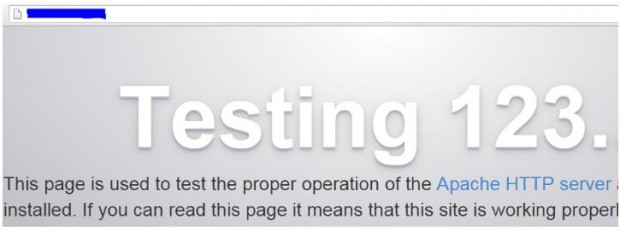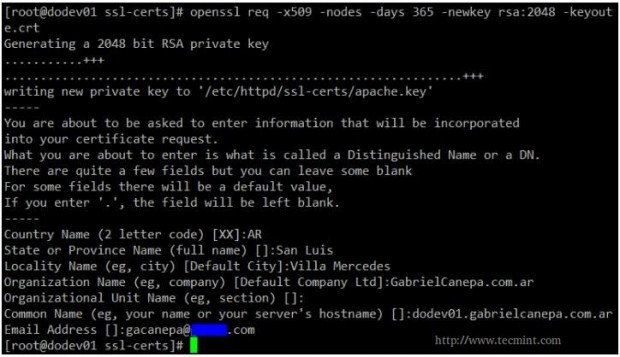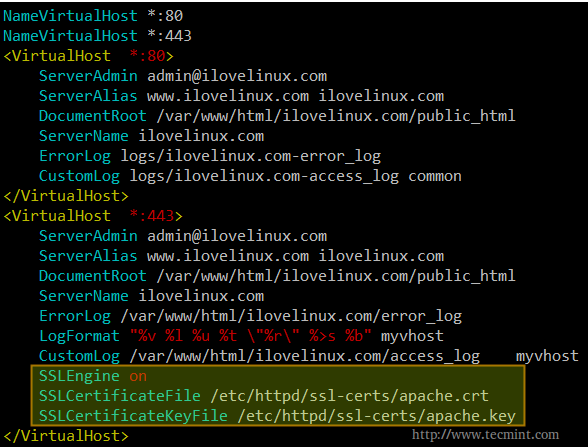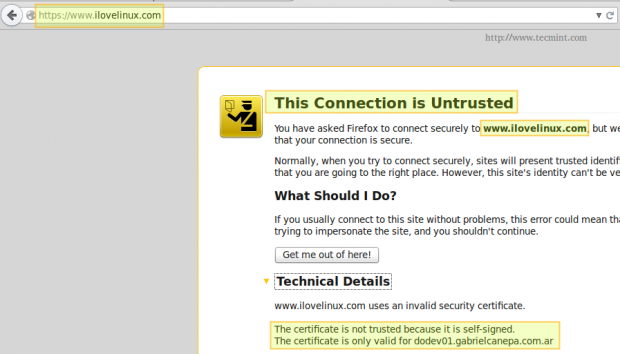How to Setup Standalone Apache Server with Name-Based Virtual Hosting with SSL Certificate – Part 4
Requirements
Please refer to Part 1 of the current series (“Installing Network Services and Configuring Automatic Startup at Boot”) for instructions on installing and starting Apache.
By now, you should have the Apache web server installed and running. You can verify this with the following command.
Note: That the above command checks for the presence of either apache or httpd (the most common names for the web daemon) among the list of running processes. If Apache is running, you will get output similar to the following.
The ultimate method of testing the Apache installation and checking whether it’s running is launching a web browser and point to the IP of the server. We should be presented with the following screen or at least a message confirming that Apache is working.
Configuring Apache
The main configuration file for Apache can be located in different directories depending on your distribution.
Fortunately for us, the configuration directives are extremely well documented in the Apache project web site. We will refer to some of them throughout this article.
Serving Pages in a Standalone Server with Apache
The most basic usage of Apache is to serve web pages in a standalone server where no virtual hosts have been configured yet. The DocumentRoot directive specifies the directory out of which Apache will serve web pages documents.
Note that by default, all requests are taken from this directory, but you can also use symbolic links and / or aliases may be used to point to other locations as well.
Unless matched by the Alias directive (which allows documents to be stored in the local filesystem instead of under the directory specified by DocumentRoot), the server appends the path from the requested URL to the document root to make the path to the document.
For example, given the following DocumentRoot:
When the web browser points to [Server IP or hostname]/lfce/tecmint.html, the server will open/var/www/html/lfce/tecmint.html (assuming that such file exists) and save the event to its access log with a 200 (OK) response.
The access log is typically found inside /var/log under a representative name, such as access.logor access_log. You may even find this log (and the error log as well) inside a subdirectory (for example, /var/log/httpd in CentOS). Otherwise, the failed event will still be logged to the access log but with a 404 (Not Found) response.
In addition, the failed events will be recorded in the error log:
The format of the access log can be customized according to your needs using the LogFormatdirective in the main configuration file, whereas you cannot do the same with the error log.
The default format of the access log is as follows:
Where each of the letters preceded by a percent sign indicates the server to log a certain piece of information:
| String | Description |
| %h | Remote hostname or IP address |
| %l | Remote log name |
| %u | Remote user if the request is authenticated |
| %t | Date and time when the request was received |
| %r | First line of request to the server |
| %>s | Final status of the request |
| %b | Size of the response [bytes] |
and nickname is an optional alias that can be used to customize other logs without having to enter the whole configuration string again.
You may refer to the LogFormat directive [Custom log formats section] in the Apache docs for further options.
Both log files (access and error) represent a great resource to quickly analyze at a glance what’s happening on the Apache server. Needless to say, they are the first tool a system administrator uses to troubleshoot issues.
Finally, another important directive is Listen, which tells the server to accept incoming requests on the specified port or address/port combination:
If only a port number is defined, the apache will listens to the given port on all network interfaces (the wildcard sign * is used to indicate ‘all network interfaces’).
If both IP address and port is specified, then the apache will listen on the combination of given port and network interface.
Please note (as you will see in the examples below) that multiple Listen directives can be used at the same time to specify multiple addresses and ports to listen to. This option instructs the server to respond to requests from any of the listed addresses and ports.
Setting Up Name-Based Virtual Hosts
The concept of virtual host defines an individual site (or domain) that is served by the same physical machine. Actually, multiple sites / domains can be served off a single “real” server as virtual host. This process is transparent to the end user, to whom it appears that the different sites are being served by distinct web servers.
Name-based virtual hosting allows the server to rely on the client to report the hostname as part of the HTTP headers. Thus, using this technique, many different hosts can share the same IP address.
Each virtual host is configured in a directory within DocumentRoot. For our case, we will use the following dummy domains for the testing setup, each located in the corresponding directory:
- ilovelinux.com – /var/www/html/ilovelinux.com/public_html
- linuxrocks.org – /var/www/html/linuxrocks.org/public_html
In order for pages to be displayed correctly, we will chmod each VirtualHost’s directory to 755:
Next, create a sample index.html file inside each public_html directory:
Finally, in CentOS and openSUSE add the following section at the bottom of/etc/httpd/conf/httpd.conf or /etc/apache2/httpd.conf, respectively, or just modify it if it’s already there.
Please note that you can also add each virtual host definition in separate files inside the/etc/httpd/conf.d directory. If you choose to do so, each configuration file must be named as follows:
In other words, you need to add .conf to the site or domain name.
In Ubuntu, each individual configuration file is named /etc/apache2/sites-available/[site name].conf. Each site is then enabled or disabled with the a2ensite or a2dissite commands, respectively, as follows.
The a2ensite and a2dissite commands create links to the virtual host configuration file and place (or remove) them in the /etc/apache2/sites-enabled directory.
To be able to browse to both sites from another Linux box, you will need to add the following lines in the /etc/hosts file in that machine in order to redirect requests to those domains to a specific IP address.
Installing and Configuring SSL with Apache
Finally, we will create and install a self-signed certificate to use with Apache. This kind of setup is acceptable in small environments, such as a private LAN.
However, if your server will expose content to the outside world over the Internet, you will want to install a certificate signed by a 3rd party to corroborate its authenticity. Either way, a certificate will allow you to encrypt the information that is transmitted to, from, or within your site.
In CentOS and openSUSE, you need to install the mod_ssl package.
Whereas in Ubuntu you’ll have to enable the ssl module for Apache.
The following steps are explained using a CentOS test server, but your setup should be almost identical in the other distributions (if you run into any kind of issues, don’t hesitate to leave your questions using the comments form).
Step 1 [Optional]: Create a directory to store your certificates.
Step 2: Generate your self signed certificate and the key that will protect it.
A brief explanation of the options listed above:
- req -X509 indicates we are creating a x509 certificate.
- -nodes (NO DES) means “don’t encrypt the key”.
- -days 365 is the number of days the certificate will be valid for.
- -newkey rsa:2048 creates a 2048-bit RSA key.
- -keyout /etc/httpd/ssl-certs/apache.key is the absolute path of the RSA key.
- -out /etc/httpd/ssl-certs/apache.crt is the absolute path of the certificate.
Step 3: Open your chosen virtual host configuration file (or its corresponding section in/etc/httpd/conf/httpd.conf as explained earlier) and add the following lines to a virtual host declaration listening on port 443.
Please note that you need to add.
at the top, right below
Both directives instruct apache to listen on ports 443 and 80 of all network interfaces.
The following example is taken from /etc/httpd/conf/httpd.conf:
Then restart Apache,
And point your browser to https://www.ilovelinux.com. You will be presented with the following screen.
Go ahead and click on “I understand the risks” and “Add exception”.
Finally, check “Permanently store this exception” and click “Confirm Security Exception”.
And you will be redirected to your home page using https.











Comments